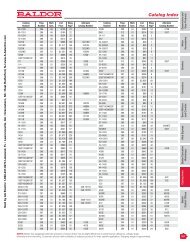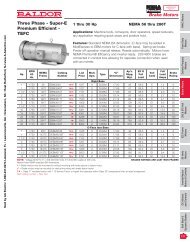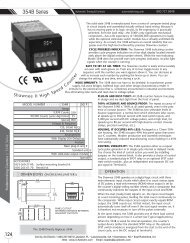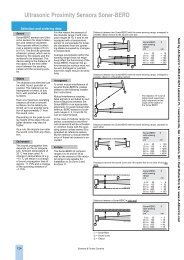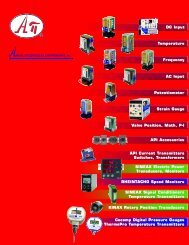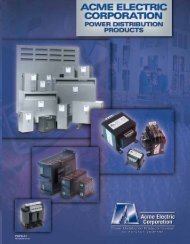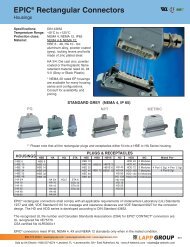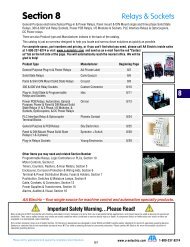CUB5P Data Sheet/Manual PDF - Ritec
CUB5P Data Sheet/Manual PDF - Ritec
CUB5P Data Sheet/Manual PDF - Ritec
You also want an ePaper? Increase the reach of your titles
YUMPU automatically turns print PDFs into web optimized ePapers that Google loves.
OPTIONAL PLUG-IN CARDS<br />
ADDING OPTION CARDS<br />
The CUB5 meters can be fitted with optional output cards and/or serial<br />
communications cards. The details for the plug-in cards can be reviewed in the<br />
specification section below. The plug-in cards, that are sold separately, can be<br />
installed initially or at a later date.<br />
WARNING: Disconnect all power to the unit before<br />
installing Plug-in card.<br />
Note: Measurement errors may occur if signal input common is shared with<br />
another circuit common (ie, serial common, Dual Sinking Output option card,<br />
or Power Supply common) on multiple units.<br />
SINGLE RELAY CARD<br />
Type: Single FORM-C relay<br />
Isolation To Sensor & User Input Commons: 1400 Vrms for 1 min.<br />
Working Voltage: 150 Vrms<br />
Contact Rating: 1 amp @ 30 VDC resistive; 0.3 amp @ 125 VAC resistive<br />
Life Expectancy: 100,000 minimum operations<br />
Response Time:<br />
Turn On Time: 4 msec max.<br />
Turn Off Time: 4 msec max.<br />
DUAL SINKING OUTPUT CARD<br />
Type: Non-isolated switched DC, N Channel open drain MOSFET<br />
Current Rating: 100 mA max.<br />
V DS ON : 0.7 V @ 100 mA<br />
V DS MAX : 30 VDC<br />
Offstate Leakage Current: 0.5 mA max.<br />
RS485 SERIAL COMMUNICATIONS CARD<br />
Type: RS485 multi-point balanced interface (non-isolated)<br />
Baud Rate: 300 to 38.4k<br />
<strong>Data</strong> Format: 7/8 bits; odd, even, or no parity<br />
Bus Address: 0 to 99; max 32 meters per line<br />
Transmit Delay: Selectable (refer to CUB5COM bulletin)<br />
RS232 SERIAL COMMUNICATIONS CARD<br />
Type: RS232 half duplex (non-isolated)<br />
Baud Rate: 300 to 38.4k<br />
<strong>Data</strong> Format: 7/8 bits; odd, even, or no parity<br />
1.0 INSTALLING THE METER<br />
INSTALLATION<br />
The meter meets NEMA 4X/IP65 requirements when properly installed. The<br />
unit is intended to be mounted into an enclosed panel. Prepare the panel cutout<br />
to the dimensions shown. Remove the panel latch from<br />
the unit. Slide the panel gasket over the rear of the<br />
unit to the back of the bezel. The unit should be<br />
installed fully assembled. Insert the unit into<br />
the panel cutout.<br />
While holding the unit in place, push the panel latch over the rear of the unit<br />
so that the tabs of the panel latch engage in the slots on the case. The panel latch<br />
should be engaged in the farthest forward slot possible. To achieve a proper seal,<br />
tighten the latch screws evenly until the unit is snug in the panel (Torque to<br />
approx. 28 to 36 in-oz [0.202 to 0.26 N-m]). Do not over-tighten the screws.<br />
INSTALLATION ENVIRONMENT<br />
The unit should be installed in a location that does not exceed the operating<br />
temperature and provides good air circulation. Placing the unit near devices that<br />
generate excessive heat should be avoided.<br />
The bezel should only be cleaned with a soft cloth and neutral soap product.<br />
Do NOT use solvents. Continuous exposure to direct sunlight may accelerate the<br />
aging process of the bezel.<br />
Do not use tools of any kind (screwdrivers, pens, pencils, etc.) to operate the<br />
keypad of the unit.<br />
2.0 SETTING THE JUMPERS<br />
INPUT RANGE JUMPER<br />
This jumper is used to select the proper input range. The input range selected<br />
in programming must match the jumper setting. Select a range that is high<br />
enough to accommodate the maximum input signal to avoid overloads. To<br />
access the jumper, remove the rear cover of the meter.<br />
Warning: Exposed line voltage exists on the circuit boards.<br />
Remove all power to the meter and load circuits before accessing<br />
inside of the meter.<br />
REMOVING THE REAR COVER<br />
To remove the rear cover, locate the cover locking tab below the 2nd and 3rd<br />
input terminals. To release the tab, insert a small, flat blade screwdriver between<br />
the tab and the plastic wall below the terminals. Inserting the screwdriver will<br />
provide enough pressure to release the tab locks. To replace the cover, align the<br />
cover with the input terminals and press down until the cover snaps into place.<br />
3



